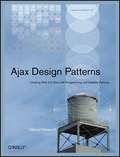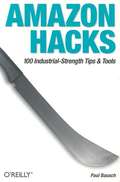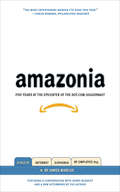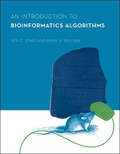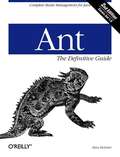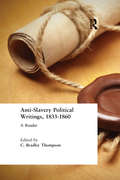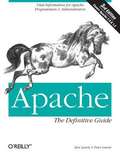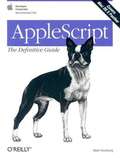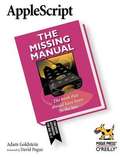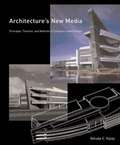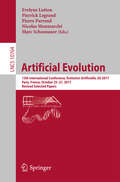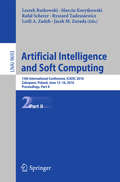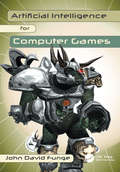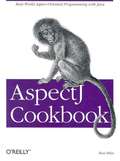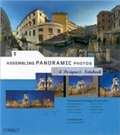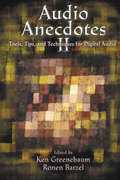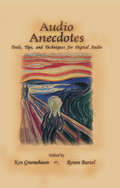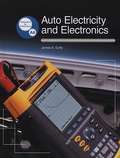- Table View
- List View
Ajax Design Patterns
by Michael MahemoffAjax, or Asynchronous JavaScript and XML, exploded onto the scene in the spring of 2005 and remains the hottest story among web developers. With its rich combination of technologies, Ajax provides a strong foundation for creating interactive web applications with XML or JSON-based web services by using JavaScript in the browser to process the web server response. Ajax Design Patterns shows you best practices that can dramatically improve your web development projects. It investigates how others have successfully dealt with conflicting design principles in the past and then relays that information directly to you. The patterns outlined in the book fall into four categories: Foundational technology: Examines the raw technologies required for Ajax development Programming: Exposes techniques that developers have discovered to ensure their Ajax applications are maintainable Functionality and usability: Describes the types of user interfaces you'll come across in Ajax applications, as well as the new types of functionality that Ajax makes possible Development: Explains the process being used to monitor, debug, and test Ajax applications Ajax Design Patterns will also get you up to speed with core Ajax technologies, such as XMLHttpRequest, the DOM, and JSON. Technical discussions are followed by code examples so you can see for yourself just what is-and isn't-possible with Ajax. This handy reference will help you to produce high-quality Ajax architectures, streamline web application performance, and improve the user experience. Michael Mahemoff holds a PhD in Computer Science and Software Engineering from the University of Melbourne, where his thesis was "Design Reuse in Software Engineering and Human-Computer Interaction." He lives in London and consults on software development issues in banking, health care, and logistics. "Michael Mahemoff's Ajax Design Patterns is a truly comprehensive compendium of web application design expertise, centred around but not limited to Ajax techniques. Polished nuggets of design wisdom are supported by tutorials and real-world code examples resulting in a book that serves not only as an intermediate to expert handbook but also as an extensive reference for building rich interactive web applications." --Brent Ashley, remote scripting pioneer
Amazon Hacks
by Paul BauschAmazon Hacks is a collection of tips and tools for getting the most out of Amazon.com, whether you're an avid Amazon shopper, Amazon Associate developing your online storefront and honing your recommendations for better linking and more referral fees, seller listing your own products for sale on Amazon.com, or a programmer building your own application on the foundation provided by the rich Amazon Web Services API. Shoppers will learn how to make the most of Amazon.com's deep functionality and become part of the Amazon community, maintain wishlists, tune recommendations, "share the love" with friends and family, etc. Amazon Associates will find tips for how best to list their titles, how to promote their offerings by fine tuning search criteria and related titles information, and even how to make their store fronts more attractive. And the real power users will use the Amazon API to build Amazon-enabled applications, create store fronts and populate them with items to be picked, packed and shipped by Amazon. And just about anyone can become a seller on Amazon.com, listing items, deciding on pricing, and fulfilling orders for products new and used.
Amazonia: Five Years at the Epicenter of the Dot.Com Juggernaut
by James MarcusFive years at the epicenter of the dot.com juggernaut
Amazonia: Five Years at the Epicenter of the Dot.com Juggernaut
by James MarcusA &“funny, contemplative&” memoir of working at Amazon in the early years, when it was a struggling online bookstore (San Francisco Chronicle). In a book that Ian Frazier has called &“a fascinating and sometimes hair-raising morality tale from deep inside the Internet boom,&” James Marcus, hired by Amazon.com in 1996—when the company was so small his e-mail address could be james@amazon.com—looks back at the ecstatic rise, dramatic fall, and remarkable comeback of the consummate symbol of late 1990s America. Observing &“how it was to be in the right place (Seattle) at the right time (the &’90s)&” (Chicago Reader), Marcus offers a ringside seat on everything from his first interview with Jeff Bezos to the company&’s bizarre Nordic-style retreats, in &“a clear-eyed, first-person account, rife with digressions on the larger cultural meaning throughout&” (Henry Alford, Newsday). &“Marcus tells his story with wit and candor.&” —Booklist, starred review
An Introduction to Bioinformatics Algorithms (Computational Molecular Biology)
by Neil C. Jones Pavel A. PevznerAn introductory text that emphasizes the underlying algorithmic ideas that are driving advances in bioinformatics.This introductory text offers a clear exposition of the algorithmic principles driving advances in bioinformatics. Accessible to students in both biology and computer science, it strikes a unique balance between rigorous mathematics and practical techniques, emphasizing the ideas underlying algorithms rather than offering a collection of apparently unrelated problems. The book introduces biological and algorithmic ideas together, linking issues in computer science to biology and thus capturing the interest of students in both subjects. It demonstrates that relatively few design techniques can be used to solve a large number of practical problems in biology, and presents this material intuitively. An Introduction to Bioinformatics Algorithms is one of the first books on bioinformatics that can be used by students at an undergraduate level. It includes a dual table of contents, organized by algorithmic idea and biological idea; discussions of biologically relevant problems, including a detailed problem formulation and one or more solutions for each; and brief biographical sketches of leading figures in the field. These interesting vignettes offer students a glimpse of the inspirations and motivations for real work in bioinformatics, making the concepts presented in the text more concrete and the techniques more approachable.PowerPoint presentations, practical bioinformatics problems, sample code, diagrams, demonstrations, and other materials can be found at the Author's website.
Analog Circuit Design for Process Variation-Resilient Systems-on-a-Chip
by Marvin Onabajo Jose Silva-MartinezThis book describes several techniques to address variation-related design challenges for analog blocks in mixed-signal systems-on-chip. The methods presented are results from recent research works involving receiver front-end circuits, baseband filter linearization, and data conversion. These circuit-level techniques are described, with their relationships to emerging system-level calibration approaches, to tune the performances of analog circuits with digital assistance or control. Coverage also includes a strategy to utilize on-chip temperature sensors to measure the signal power and linearity characteristics of analog/RF circuits, as demonstrated by test chip measurements. Describes a variety of variation-tolerant analog circuit design examples, including from RF front-ends, high-performance ADCs and baseband filters;Includes built-in testing techniques, linked to current industrial trends;Balances digitally-assisted performance tuning with analog performance tuning and mismatch reduction approaches;Describes theoretical concepts as well as experimental results for test chips designed with variation-aware techniques.
Ant: The Definitive Guide, 2nd Edition
by Steve HolznerSoon after its launch, Ant succeeded in taking the Java world by storm, becoming the most widely used tool for building applications in Java environments. Like most popular technologies, Ant quickly went through a series of early revision cycles. With each new version, more functionality was added, and more complexity was introduced. Ant evolved from a simple-to-learn build tool into a full-fledged testing and deployment environment. Ant: The Definitive Guide has been reworked, revised and expanded upon to reflect this evolution. It documents the new ways that Ant is being applied, as well as the array of optional tasks that Ant supports. In fact, this new second edition covers everything about this extraordinary build management tool from downloading and installing, to using Ant to test code. Here are just of a few of the features you'll find detailed in this comprehensive, must-have guide: Developing conditional builds, and handling error conditions Automatically retrieving source code from version control systems Using Ant with XML files Using Ant with JavaServer Pages to build Web applications Using Ant with Enterprise JavaBeans to build enterprise applications Far exceeding its predecessor in terms of information and detail, Ant: The Definitive Guide , 2nd Edition is a must-have for Java developers unfamiliar with the latest advancements in Ant technology. With this book at your side, you'll soon be up to speed on the premiere tool for cross-platform development. Author Steve Holzner is an award-winning author who s been writing about Java topics since the language first appeared; his books have sold more than 1.5 million copies worldwide.
Anti-Slavery Political Writings, 1833-1860: A Reader
by C. Bradley ThompsonThe abolitionist movement in 19th century America led directly to the end of slavery in the United States. This collection of more than 20 original documents including speeches, editorials, books and fiction, captures the deep ideological divisions within the abolitionist movement.
Apache: The Definitive Guide, 3rd Edition
by Ben Laurie Peter LaurieUpdated to cover the changes in Apache's latest release, 2.0, as well as Apache 1.3, this useful guide discusses how to obtain, set up, secure, modify, and troubleshoot the Apache software on both Unix and Windows systems. In addition to covering the installation and configuration of mod_perl and Tomcat, the book examines PHP, Cocoon, and other new technologies that are associated with the Apache web server.
Apache: The Definitive Guide, 3rd Edition
by Ben Laurie Peter LaurieApache is far and away the most widely used web server platform in the world. This versatile server runs more than half of the world's existing web sites. Apache is both free and rock-solid, running more than 21 million web sites ranging from huge e-commerce operations to corporate intranets and smaller hobby sites. With this new third edition of Apache: The Definitive Guide , web administrators new to Apache will come up to speed quickly, and experienced administrators will find the logically organized, concise reference sections indispensable, and system programmers interested in customizing their servers will rely on the chapters on the API and Apache modules. Updated to cover the changes in Apache's latest release, 2.0, as well as Apache 1.3, this useful guide discusses how to obtain, set up, secure, modify, and troubleshoot the Apache software on both Unix and Windows systems. Dozens of clearly written examples provide the answers to the real-world issues that Apache administrators face everyday. In addition to covering the installation and configuration of mod_perl and Tomcat, the book examines PHP, Cocoon, and other new technologies that are associated with the Apache web server. Additional coverage of security and the Apache 2.0 API make Apache: The Definitive Guide , Third Edition essential documentation for the world's most popular web server.
AppleScript: The Definitive Guide
by Matt NeuburgAppleScript: The Definitive Guide explores and teaches the language from the ground up. If you're a beginner and want to learn how to write your first script or just understand what the excitement is all about, you'll be able to do so after reading this book. Experienced AppleScripters will love having the most definitive, up-to-date AppleScript language reference available.
AppleScript: The Definitive Guide
by Matt NeuburgIf you want to know all about AppleScript--the how, where, and why of using it--dig into AppleScript: The Definitive Guide . It doesn't make the mistake that other books do: it isn't about scripting this or that particular application, and it doesn't assume that learning AppleScript is easy or obvious. Instead, the book teaches and documents the language in a clear and rigorous manner, just as you'd expect with any programming or scripting language. AppleScript is a dynamic, object-oriented scripting system that allows Mac users--even novices who know nothing about programming--to directly control Macintosh applications, including the Mac OS itself. You can write scripts to automate repetitive tasks, customize applications, and even control complex workflows. AppleScript has always been useful, but with Mac OS X it's even more so. Nearly every application that comes with Mac OS X is scriptable. Even non-scriptable applications can often be driven with AppleScript, thanks to the new Accessibility API and GUI Scripting technologies. And now AppleScripters can put a true Aqua interface around their scripts! There's never been a more exciting time for AppleScript users. AppleScript: The Definitive Guide explores and teaches the language from the ground up. If you're a beginner and want to learn how to write your first script or just understand what the excitement is all about, you'll be able to do so after reading this book. AppleScript: The Definitive Guide is the quintessential guide to this important Mac tool. Regardless of their level of experience, AppleScripters everywhere will turn to this book again and again.
AppleScript: The Missing Manual
by Adam GoldsteinFrom newspapers to NASA, Mac users around the world use AppleScript to automate their daily computing routines. Famed for its similarity to English and its ease of integration with other programs, AppleScript is the perfect programming language for time-squeezed Mac fans. As beginners quickly realize, however, AppleScript has one major shortcoming: it comes without a manual. No more. You don't need a degree in computer science, a fancy system administrator title, or even a pocket protector and pair of nerdy glasses to learn the Mac's most popular scripting language; you just need the proper guide at your side. AppleScript: The Missing Manual is that guide. Brilliantly compiled by author Adam Goldstein, AppleScript: The Missing Manual is brimming with useful examples. You'll learn how to clean up your Desktop with a single click, for example, and how to automatically optimize pictures for a website. Along the way, you ll learn the overall grammar of AppleScript, so you can write your own customized scripts when you feel the need. Naturally, AppleScript: The Missing Manual isn't merely for the uninitiated scripter. While its hands-on approach certainly keeps novices from feeling intimidated, this comprehensive guide is also suited for system administrators, web and graphics professionals, musicians, scientists, mathematicians, engineers, and others who need to learn the ins and outs of AppleScript for their daily work. Thanks to AppleScript: The Missing Manual , the path from consumer to seasoned script has never been clearer. Now you, too, can automate your Macintosh in no time.
Applied Software Project Management
by Jennifer Greene Andrew Stellman"If you're looking for solid, easy-to-follow advice on estimation, requirements gathering, managing change, and more, you can stop now: this is the book for you." --Scott Berkun, Author of The Art of Project Management What makes software projects succeed? It takes more than a good idea and a team of talented programmers. A project manager needs to know how to guide the team through the entire software project. There are common pitfalls that plague all software projects and rookie mistakes that are made repeatedly--sometimes by the same people! Avoiding these pitfalls is not hard, but it is not necessarily intuitive. Luckily, there are tried and true techniques that can help any project manager. In Applied Software Project Management , Andrew Stellman and Jennifer Greene provide you with tools, techniques, and practices that you can use on your own projects right away. This book supplies you with the information you need to diagnose your team's situation and presents practical advice to help you achieve your goal of building better software. Topics include: Planning a software project Helping a team estimate its workload Building a schedule Gathering software requirements and creating use cases Improving programming with refactoring, unit testing, and version control Managing an outsourced project Testing software Jennifer Greene and Andrew Stellman have been building software together since 1998. Andrew comes from a programming background and has managed teams of requirements analysts, designers, and developers. Jennifer has a testing background and has managed teams of architects, developers, and testers. She has led multiple large-scale outsourced projects. Between the two of them, they have managed every aspect of software development. They have worked in a wide range of industries, including finance, telecommunications, media, nonprofit, entertainment, natural-language processing, science, and academia. For more information about them and this book, visit http://www.stellman-greene.com .
Architecture's New Media: Principles, Theories, and Methods of Computer-Aided Design
by Yehuda E. KalayA comprehensive examination of computer-aided architectural design and its potential effect on architectural design practice, for practitioners, educators, students, and researchers.
Artificial Evolution: 6th International Conference, Evolution Artificielle, EA 2003, Marseilles, France, October 27-30 2003 (Lecture Notes in Computer Science #2936)
by Pierrick Legrand Nicolas Monmarché Evelyne Lutton Marc Schoenauer Pierre ParrendThis book constitutes the thoroughly refereed post-proceedings of the 6th International Conference on Artificial Evolution, EA 2003, held in Marseilles, France in October 2003.<P><P> The 32 revised full papers presented were carefully selected and improved during two rounds of reviewing and revision. The papers are organized in topical sections on theoretical issues, algorithmic issues, applications, implementation issues, genetic programming, coevolution and agent systems, artificial life, and cellular automata.
Artificial Intelligence and Soft Computing: 15th International Conference, ICAISC 2016, Zakopane, Poland, June 12-16, 2016, Proceedings, Part II (Lecture Notes in Computer Science #9693)
by Lotfi A. Zadeh Leszek Rutkowski Marcin Korytkowski Rafał Scherer Ryszard Tadeusiewicz Jacek M. ZuradaThis volume constitutes the proceedings of the 7th Conference on Arti?cial Intelligence and Soft Computing, ICAISC2004, held in Zakopane, Poland, June 7 11, 2004. The conference was organized by the Polish Neural Network Society in cooperation with the Department of Computer Engineering at the Tech- calUniversityofCzesto, chowa, WSHE University in L od z and IEEE Neural Networks Society. The previous conferences took place in Kule (1994), Szczyrk (1996), Kule (1997) and Zakopane (1999, 2000, 2002) and attracted a large number of papers and internationally recognized speakers: Prof. Lot? A. Zadeh, Prof. RobertMarks, Prof. EnriqueRuspini, Prof. Zdzis lawBubnicki, Prof. Jacek ? Zurada, Prof. Shun-ichi Amari, Prof. Kaoru Hirota, Prof. Ryszard Tadeusiewicz, Prof. Shiro Usui, Prof. W lodzis law Duch, Prof. Erkki Oja, Prof. Syozo Yasui, Prof. Witold Pedrycz, Prof. Janusz Kacprzyk, Prof. Laszlo T. Koczy, Prof. Soo- Young Lee and Prof. Daniel Amit. The aim of this conference is to build a bridge between traditional arti?cial intelligence techniques and recently developed soft computing techniques. It was pointed out by Prof. Lot? A. Zadeh that Soft Computing (SC) is a coalition of methodologies which are oriented toward the conception and design of information/intelligent systems. The principal m- bers of the coalition are: fuzzy logic (FL), neurocomputing (NC), evolutionary computing (EC), probabilistic computing (PC), chaotic computing (CC), and machine learning (ML). The constituent methodologies of SC are, for the most part, complementary and synergisticrather than competitive . Thisvolumep- sents both traditional arti?cial intelligence methods and soft computing tech- ques presented in 14 parts: 1. "
Artificial Intelligence for Computer Games: An Introduction
by John David FungeLearn to make games that are more fun and engaging! Building on fundamental principles of Artificial Intelligence, Funge explains how to create Non-Player Characters (NPCs) with progressively more sophisticated capabilities. Starting with the basic capability of acting in the game world, the book explains how to develop NPCs who can perceive, remem
AspectJ Cookbook
by Russell MilesWhen Object Oriented programming (OO) first appeared, it was a revelation. OO gave developers the ability to create software that was more flexible and robust, but as time went on and applications became more sophisticated, too, certain areas of "traditional" OO architectures were found wanting. Aspect-oriented programming (AOP) addresses those issues by extending the OO approach even further. Many developers are interested in AOP--especially in AspectJ, the open source extension of the Java programming language that explicitly supports the AOP approach. Yet, although AspectJ is included with Eclipse, the increasingly popular open source IDE for Java, finding a practical and non-theoretical way to learn this language and other AOP tools and techniques has been a real problem. Until now. The AspectJ Cookbook offers a hands-on solution--in fact, several--with a wide variety of code recipes for solving day-to-day design and coding problems using AOP's unique approach. AOP allows the global properties of a program to determine how it's compiled into an executable program. Before AOP, important program design decisions were difficult to capture in actual code. Instead, the implementation of those design decisions--known as "aspects"--were scattered throughout, resulting in "tangled" code that was hard to develop and maintain. AOP has been compared to the manufacturing of cloth, in which threads are automatically interwoven. Without AOP, programmers must stitch the threads by hand. The AspectJ Cookbook shows readers why, and how, common Java development problems can be solved by using AOP techniques. With our popular problem-solution-discussion format, the book presents real world examples to demonstrate that AOP is more than just a concept; it's a development process that will benefit users in an immediate and visible manner. If you're interested in how AOP is changing the way software is developed, and how you can use AspectJ to make code more modular, easier to develop, maintain, evolve and deploy, this is the book that really delivers.
Assembling Panoramic Photos: A Designer's Notebook
by William RodarmorIn this full-color Designer's Notebook, eight expert French photographers reveal their secrets in using Photoshop and a collection of dedicated applications to create extraordinary panoramic photos--including some amazing 360-degree images. For anyone involved with digital imagery or animation, this groundbreaking volume demonstrates a new way of thinking about what's possible and what's required to produce these images. Originally published in France, Assembling Panoramic Photos: A Designer's Notebook is available in English for the first time. Part art book, part how-to guide, this stunning work takes you right into the studio and sits you down next to renowned digital artists as they advance step-by-step toward their final images. The showcased pieces are inspiring and avant-garde, and the techniques are instructive for a wide range of amateur and professional photographers, graphic designers, and digital artists. The artists featured in this Designer's Notebook show how they use Photoshop, Stitcher, PanaVue ImageAssembler, and other specialized tools to create high-quality panoramas and wide-angle images from a series of photos. They also show how to create virtual reality scenes with Apple's QuickTime VR in conjunction with leading-edge technologies that support 360-degree one-shot photos, cubic images, and 3D views of objects. The results are interactive, often startling, and bear the hallmark of each artist's original vision and skill. Reflecting the very best of French photography, graphic design and digital artistry, Assembling Panoramic Photos: A Designer's Notebook offers advanced Photoshop instruction that goes beyond opening this menu, or clicking that palette. You receive expert aesthetic guidance, from start to finish, with notes and views that reveal every step of the process. This book is a goldmine for any digital artist who wants to learn new Photoshop techniques and exploit them for maximum effect. At home on either your coffee table or desktop, the book itself is dazzling in concept and design. There's nothing else quite like this Designer's Notebook available in the U.S.
Assessing Network Security
by David Leblanc Ben Smith Kevin LamWritten by members of the Microsoft security team, this book presents network testing strategies, including vulnerability scanning and penetration testing. It provides guidance on how to perform security assessments, uncover vulnerabilities, and apply appropriate countermeasures. A companion CD contains the text of the book, plus tools and scripts for securing email, databases, and web servers. Annotation ©2004 Book News, Inc. , Portland, OR (booknews. com)
Audio Anecdotes II: Tools, Tips, and Techniques for Digital Audio
by Ken Greenebaum Ronen BarzelThis collection of articles provides practical and relevant tools, tips, and techniques for those working in the digital audio field. Volume II, with contributions from experts in their fields, includes articles on: - Field recording - Synthesis - Signal processing - Spatialization - Computer techniques and tools - Music theory - Sound design - Sou
Audio Anecdotes: Tools, Tips, and Techniques for Digital Audio
by Ken Greenebaum Ronen BarzelAudio Anecdotes is a book about digital sound. It discusses analyzing, processing, creating, and recording many forms of sound and music, emphasizing the opportunities presented by digital media made possible by the arrival of inexpensive and nearly ubiquitous digital computing equipment. Applications of digital audio techniques are indispensable i
Auto Electricity and Electronics
by James E. DuffyDeals with the operation, diagnosis, and service of the electrical, electronic, and computer control systems found on today's automobiles and light trucks.
BLAST
by Joseph Bedell Ian Korf Mark YandellSequence similarity is a powerful tool for discovering biological function. Just as the ancient Greeks used comparative anatomy to understand the human body and linguists used the Rosetta stone to decipher Egyptian hieroglyphs, today we can use comparative sequence analysis to understand genomes. BLAST (Basic Local Alignment Search Tool), is a sophisticated software package for rapid searching of nucleotide and protein databases. It is one of the most important software packages used in sequence analysis and bioinformatics. Most users of BLAST, however, seldom move beyond the program's default parameters, and never take advantage of its full power. BLAST is the only book completely devoted to this popular suite of tools. It offers biologists, computational biology students, and bioinformatics professionals a clear understanding of BLAST as well as the science it supports. This book shows you how to move beyond the default parameters, get specific answers using BLAST, and how to interpret your results. The book also contains tutorial and reference sections covering NCBI-BLAST and WU-BLAST, background material to help you understand the statistics behind BLAST, Perl scripts to help you prepare your data and analyze your results, and a wealth of tips and tricks for configuring BLAST to meet your own research needs. Some of the topics covered include: BLAST basics and the NCBI web interface How to select appropriate search parameters BLAST programs: BLASTN, BLASTP, BLASTX, TBLASTN, TBLASTX, PHI-BLAST, and PSI BLAST Detailed BLAST references, including NCBI-BLAST and WU-BLAST Understanding biological sequences Sequence similarity, homology, scoring matrices, scores, and evolution Sequence Alignment Calculating BLAST statistics Industrial-strength BLAST, including developing applications with Perl and BLAST BLAST is the only comprehensive reference with detailed, accurate information on optimizing BLAST searches for high-throughput sequence analysis. This is a book that any biologist should own.
